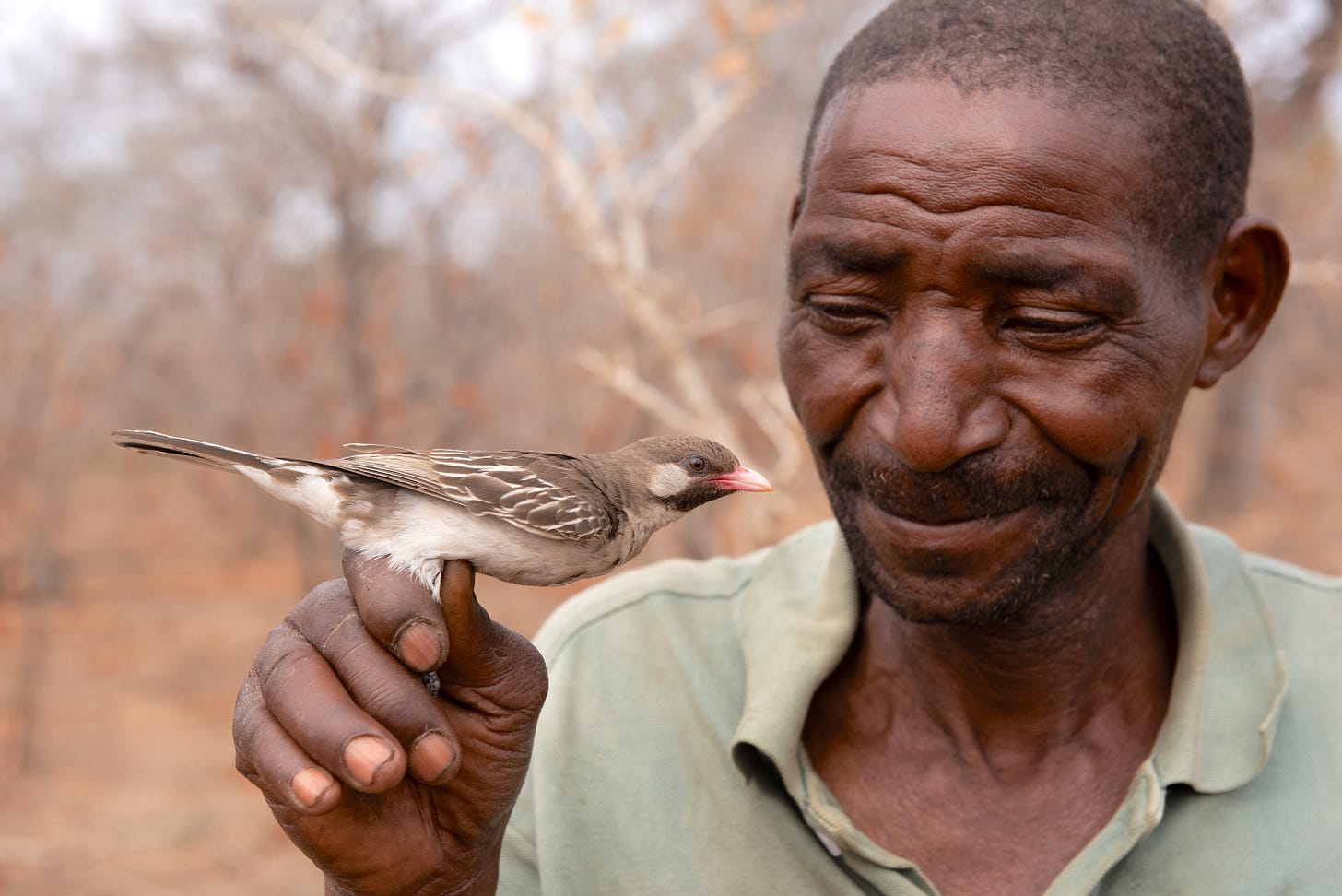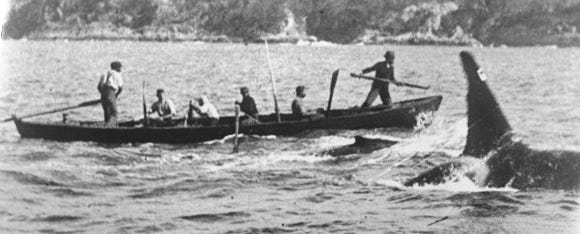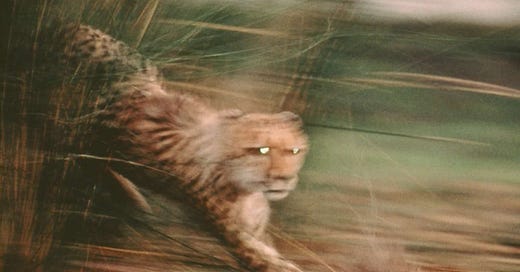My Misguided Life Among Killers
I sometimes tell the "nature red in tooth & claw" story. But is it a lie?
By Richard Conniff
The success of my work as a wildlife writer has depended, more often than I like to think, on witnessing something kill something else when I was nearby--African wild dogs taking down an impala, or a tarantula in Peru pouncing on a frog and slowly liquefying its carcass. (Tarantulas inject enzymes for “external digestion” and consume their prey as a liquid diet. This may be more than you really want to know on a Saturday morning.)
The focus on predation suited my temperament and, more importantly, it suited the magazines that sent me to various far-flung destinations. Once, for a National Geographic story, I spent a couple of weeks in Botswana and Namibia watching unsuccessfully for cheetahs to make a kill. (There’d been a lot of rain, the grass was tall, and my luck was bad.) I headed home, thinking I had enough cheetah sightings full of grooming and other behaviors to write a good story.
My editors thought otherwise. They sent me back—Yay!—for a bit more time in the field. Another week or more in Botswana again proved bloodless (tall grass, etc.). So I hopped onto a series of planes, Maun to Jo’burg, Jo’burg to Arusha, and then Arusha via a 12-seat puddle jumper to wherever the passengers fancied. After a couple of hours, with just the pilot and I left onboard, we swooped down to clear the wildebeests off a grass airfield and landed in the Serengeti.
There, courtesy of cheetah biologist Sarah Durant, we experienced what was for both of us the bloodiest days of our lives. It was the season for antelope to produce their fawns. They were “tender, glossy-eyed creatures on unsteady legs,” as I wrote in my revised article. “Their mothers bedded them down under grassy tussocks and whistling thorn acacias, hoping they would go unnoticed until they were strong enough to run with the herd.”
It didn’t work out that way. A cheetah named Talisker watched fondly as her four cubs wandered through the fawn nursery picking off newborn impalas and gazelles like children on an Easter egg hunt.
Then Talisker spotted larger prey. A young wildebeest had made the fatal mistake of getting separated from the herd. After a short chase, the cheetah, still running, reached out and swatted the wildebeest across the haunches with her forepaw, driving it down in a tumult of dust. The wildebeest struggled to its feet and reared up to shake off the thing now locked onto its windpipe. Talisker went up on her hind legs and hung on. The four cubs came bounding up from behind—look ma, look what we can do!—and shoved the wildebeest back down again …
Well, you get the idea. It was exciting stuff. It also fit an idea embedded deep in our culture, that nature is “red in tooth and claw,” as Tennyson wrote. (Here’s a good perspective on the context of that line.) Or that “the whole of nature,” is “a conjugation of the verb to eat, in the active and passive,” as a Victorian clergyman put it. (The reverend liked that phrase so much he recycled it to describe the whole of history.)
I’m writing about all this now because I’ve come to think our fixation on predators may have led us to misunderstand the natural world. We can hardly help ourselves: Paying attention to predators is a natural behavior, motivated by the prospect of getting dinner, and the fear of being gotten for dinner. We watch because it’s impossible not to fixate on the nasty, brutish, and short character of predatory acts.
But focusing single-mindedly on what’s most exciting can lead us to overlook a whole array of other behaviors that characterize the natural world in more subtle ways. I’m thinking particularly of when separate species co-evolve in ways that prove mutually beneficial to them both. Pollinators and seed dispersers are the obvious examples.

Other unexpected forms of mutualism also abound. Sometimes these partnerships amount to a mutual defense pact. In Sri Lanka, for instance, a tarantula shares its tree hole with a tiny frog it could easily kill and eat. Instead, the tarantula keeps off snakes and other potential enemies of the frog. The frog in turn eats ants that would otherwise prey on the tarantula’s eggs.
Even more improbably, wild animals sometimes engage in mutually beneficial partnerships with humans. The sub-Saharan birds called greater honeyguides, for instance, seek out human honey-hunters (and vice versa) with specialized calls. The birds then lead the way to treetop beehives. The human honey hunters climb up, smoke out the hive, and gain access to the prize, which they share--honey for the humans, beeswax for the birds.
And at Two Folds Bay in Australia, until the end of the nineteenth century, orca whales would splash to attract human whalers and lead them to their prey, or even drive the baleen whales up against the shoreline for the humans to harpoon. The whalers knew enough to let the orcas take the tongues of their prey before breaking up the rest of the carcass.

It has become increasingly evident in recent decades that mutualistic behaviors are the main business of ordinary life. They are everywhere, not just on some African savanna, but all around and within us. “Every species on earth is involved directly or indirectly in one or more mutualistic partnerships; some are involved in hundreds,” the co-authors of the 2015 book Mutualism wrote.
If you doubt it, think about all the hundreds of separate microbial species that have evolved to live on and within us. (Oh, damn, another regrettable thought for a Saturday morning.) Over the past two decades, microbiome research has taught us that these mutualistic partners haven’t just evolved to digest our food. They also shape our immune response, our moods, and even how we think.
I’ll be writing more about mutualistic partnerships in the coming weeks or months. So I’ll just finish for now with this thought. There is nothing sentimental about these partnerships, not even when it’s something as lovely as, say, a black swallowtail butterfly pollinating the butterfly weed in your garden. Mutualistic partnerships did not evolve, in the words of a 2003 religious text, as part of “God’s big idea” for a win-win world. They evolved under the relentless pressure of natural and sexual selection.
Flowering plants do not produce nectar because they want to feed beneficial insects, nor do insects develop elaborate adaptations for feeding on the nectar of a particular flowering plant because they want to help reproduce the plant. Each evolves to serve it own needs, not to benefit its partner. The beauty of it all is that, as they co-evolve over the course of lifetimes and generations, these partnerships have emerged, and found a place within a vast network of other partnerships that comprise nature and human life as know it.
O.k., I’m sure I’ll still be writing about predators. I’m an old dog now, and like my old tricks. Even the co-authors of that 2015 book Mutualism acknowledge that “Watching something kill something else may simply be more exciting than watching cooperation in action.”
But I’ll also be listening much more closely now to the deeper music of mutualisms.
Letting In the Light

Coincidentally, my favorite science story of the week is about a mutualistic partnership. Ocean algae have often evolved to find shelter from the currents by making their homes inside corals and shellfish. These marine animals have in turn evolved to depend on the algae for nutrients.
The algae need sunlight for photosynthesis to produce those nutrients. But sunlight can be hard to come by when you live inside a shellfish. Giant clams help their algae out “by gaping their shell open to bathe their mantle in downwelling sunlight,” according to a new study in the journal Nature Communications. But that exposes the clam’s soft mantle to potential predation and to harmful ultraviolet light.
Another type of heart-shaped bivalve, called heart cockles, have found a better way. They keep their shells closed but have evolved windows in the shell surface to bathe their interiors in light. “If placed in the shade, a heart cockle will move to the sun,” the co-authors of the new study report. “If the sun-facing half of a heart cockle is covered with sand or mud, it will use its foot to sweep its shell clean.”
In some heart cockle species, these windows are triangular (at left in the photo above) and in others they occur as stripes (at right). But what’s more remarkable is that the windows use “natural nanophotonics” to screen out much of the harmful ultraviolet radiation and transmit more than twice as much of the sunlight that the algae need for photosynthesis.
Underneath these windows, on the interior of the shell, the heart cockles also have transparent bumps that function as “fiber optic bundles” to condense the incoming sunlight. That allows the light to penetrate more deeply into the photosynthetic tissue.
So how does all that adaptation help? When corals encounter water warmed by climate change, they tend to expel their algae partners—and die. The study authors theorize that the cockles and their algae may be less vulnerable to that that kind of bleaching event.
If you’d like to hear more, check out their interview on NPR’s “All Things Considered.”
Richard Conniff’s books include The Species Seekers: Heroes, Fools and the Mad Pursuit of Life on Earth (W.W. Norton), Spineless Wonders: Strange Tales of the Invertebrate World (Henry Holt), and House of Lost Worlds: Dinosaurs, Dynasties, and the Story of Life on Earth (Yale). He is a former contributing opinion writer for The New York Times, and a National Magazine Award-winning feature writer for Smithsonian, National Geographic, The Atlantic, and other publications.





I love this! Cooperation is all around us! It is always very funny to me which human qualities are often labeled "anthropomorphization" (cooperation, etc) and which are seen as inherently universal (competition).
Wouldn’t it be lovely for the rest of us to evolve in such a fashion 💕